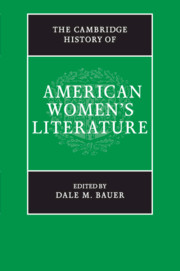Book contents
- Frontmatter
- Contents
- List of illustrations
- Acknowledgements
- Notes on contributors
- Introduction
- 1 The stories we tell: American Indian women's writing and the persistence of tradition
- 2 Women writers and war
- 3 American women's writing in the colonial period
- 4 Religion, sensibility, and sympathy
- 5 Women's writing of the Revolutionary era
- 6 Women writers and the early US novel
- 7 Women in literary culture during the long nineteenth century
- 8 Moral authority as literary property in mid-nineteenth-century print culture
- 9 The shape of Catharine Sedgwick's career
- 10 Writing, authorship, and genius: literary women and modes of literary production
- 11 Nineteenth-century American women's poetry: past and prospects
- 12 Transatlantic sympathies and nineteenth-century women's writing
- 13 Nineteenth-century African American women writers
- 14 Local knowledge and women's regional writing
- 15 Women and children first: female writers of American children's literature
- 16 US suffrage literature
- 17 American women playwrights
- 18 Turn-of-the-twentieth-century transitions: women on the edge of tomorrow
- 19 Accidents, agency, and American literary naturalism
- 20 The geography of ladyhood: racializing the novel of manners
- 21 Self-made women: novelists of the 1920s
- 22 Recovering the legacy of Zara Wright and the twentieth-century black woman writer
- 23 Jewish American women writers
- 24 Women on the breadlines
- 25 Modern domestic realism in America, 1950–1970
- 26 Lyric, gender, and subjectivity in modern and contemporary women's poetry
- 27 Contemporary American women's writing: women and violence
- 28 Asian American women's literature and the promise of committed art
- 29 Straight sex, queer text: American women novelists
- 30 Latina writers and the usable past
- 31 Where is she? Women/access/rhetoric
- 32 Reading women in America
- Index
- References
18 - Turn-of-the-twentieth-century transitions: women on the edge of tomorrow
Published online by Cambridge University Press: 28 September 2012
- Frontmatter
- Contents
- List of illustrations
- Acknowledgements
- Notes on contributors
- Introduction
- 1 The stories we tell: American Indian women's writing and the persistence of tradition
- 2 Women writers and war
- 3 American women's writing in the colonial period
- 4 Religion, sensibility, and sympathy
- 5 Women's writing of the Revolutionary era
- 6 Women writers and the early US novel
- 7 Women in literary culture during the long nineteenth century
- 8 Moral authority as literary property in mid-nineteenth-century print culture
- 9 The shape of Catharine Sedgwick's career
- 10 Writing, authorship, and genius: literary women and modes of literary production
- 11 Nineteenth-century American women's poetry: past and prospects
- 12 Transatlantic sympathies and nineteenth-century women's writing
- 13 Nineteenth-century African American women writers
- 14 Local knowledge and women's regional writing
- 15 Women and children first: female writers of American children's literature
- 16 US suffrage literature
- 17 American women playwrights
- 18 Turn-of-the-twentieth-century transitions: women on the edge of tomorrow
- 19 Accidents, agency, and American literary naturalism
- 20 The geography of ladyhood: racializing the novel of manners
- 21 Self-made women: novelists of the 1920s
- 22 Recovering the legacy of Zara Wright and the twentieth-century black woman writer
- 23 Jewish American women writers
- 24 Women on the breadlines
- 25 Modern domestic realism in America, 1950–1970
- 26 Lyric, gender, and subjectivity in modern and contemporary women's poetry
- 27 Contemporary American women's writing: women and violence
- 28 Asian American women's literature and the promise of committed art
- 29 Straight sex, queer text: American women novelists
- 30 Latina writers and the usable past
- 31 Where is she? Women/access/rhetoric
- 32 Reading women in America
- Index
- References
Summary
Introduction
In the United States at the end of the nineteenth century, well-documented changes in daily life opened new horizons for women. During the first two decades of the twentieth century, as Jo Ann Argersinger writes, “the forces of industrialization transformed American society with an intensity that shattered traditions and stirred imaginations” (Triangle Fire, 2). The labor force swelled with thousands of new immigrants; the Great Migration of African Americans from rural to urban areas began around 1912; and while many American women had been working for decades, housebound middle-class women also began to go to work. As Jean-Michel Rabaté wrote, “urban America changed more between 1890–1910 than in the whole previous century” (1913, 16). One of the largest industries to which women flocked was the ready-to-wear clothing industry. New modes of production, improved technologies like the steam-powered sewing machines of the 1870s, marketing, advertising, and distribution made for increased consumption. Consumption mirrored class aspiration, allowing for “the working class's ‘dream world’ of bourgeois consumption” to parallel “the bourgeoisie's ‘dream world’ of aristocratic forms,” argues Nancy L. Green in Ready to Wear, Ready to Work: A Century of Industry and Immigrants in Paris and New York. Sweatshop worker Sadie Frowne wrote in 1902, “a girl must have clothes if she is to go into high society at Ulmer Park or Coney Island or the theatre . . . a girl who does not dress well is stuck in a corner, even if she is pretty, and Aunt Fanny says that I do just right to put on plenty of style” (Argersinger, Triangle Fire, 55).
- Type
- Chapter
- Information
- The Cambridge History of American Women's Literature , pp. 369 - 386Publisher: Cambridge University PressPrint publication year: 2012
References
- 1
- Cited by



